Ivory Alternative: Tagua Nut
A Renewable Resource You May Already be Wearing
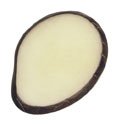 Tagua
Tagua nuts have a varied history for the west, acting as a ballast medium for ships setting sail from South America*. This material has been popular for a long time as a substitute for ivory and has been making a comeback as a material for buttons and jewelry. It’s also used for making carvings such as netsuke and other small adornments. Tagua was used by the US Army during World War II for uniforms, gradually being replaced with plastics afterward.
What Is Tagua Nut?
Tagua nut is the seed of a palm known as Phytelipas Aequatoralis, it does have a distant cousin in the Solomon Islandsknown as ivory nut and Metroxylon amicorum from the Caroline Islands of Micronesia, as well as Hyphaene ventricosa from the Zambezi River of Africa*. Tagua nut is the most plentiful and accessible. It is a dense seed that is dried then either cut or sometimes sanded and polished as is and can be found on Amazon.com.
As a wood, it is one of the densest around and inside, it has a challenging secret: there are almost always voids, so acquiring a tagua nut with the intent of slabbing it will end in a lot of waste and frustration. On the upside, you can get them pre-cut with slabs or “potato chips” in thicknesses from 1/8″ to almost 3/8″ (3.2mm to 9.5mm).
Scrimshaw and Tagua Nut
Tagua nut polishes to a high luster and looks like a great substitute at first, and can be as long as you follow a few guidelines:
- Sand and polish to at least 3000 grit starting at about 150 grit, first in one direction, then perpendicularly when you move to the next finer grit (up and down for 150 grit, back and forth for 300 grit, up and down for 600 grit, etc.)
- Let it sit between steps for at least one day. Sanding to about 1000 grit will heat the wood making it expand slightly. If you are using machines it will probably heat it up even more (we always rough sand flat, wait a day, then progressively sand to 600 grit, wait one day, then do the final sanding to 3000 grit).
- As you will see, HUT Wax
applied with a felt wheel has given us the best results so far (yes, wait one day, polish, wait one day, then scrim)
- India ink has a tendency to stain, using oil paint and wiping it off wet is the best way to make your scrimshaw appear.
- Scrimshaw everything first – repeated coatings of pigments will get under even some of the best coatings and stain the micro-pores within the tagua nut. This can be tricky if you’re first starting out scrimshawing, but it will yield the best results.
A fine (000) paint brush and careful application will allow you to fill in darker areas but at this point you will need to paint carefully and let the paint dry completely, don’t try to wipe it off, since you can’t repolish once you’ve scrimshawed.
Another way around the micro-pores issue is to send your material out to have it stabilized, or stabilize it yourself. There are several YouTube videos that show people stabilizing their own using vacuums and MinWax wood restorer. We tried this and found the distillates disintegtrated the latex seals quickly making a sticky smelly mess (it did take a couple of days for this to occur, it wasn’t minutes), and the creamy white tagua nut turned an antique yellow. We’ll continue to experiment, but you may also want to try sending some samples to businesses that specialize in stabilizing wood and antler.
One other idea that looked good on paper that didn’t work was to spray the tagua nut with spray varnish. This left a film that was difficult to scrim, peeled, and ended up unsuitable.
Summary
Tagua nut can be a good eco-friendly substitute for ivory as long as precautions are taken and a commitment to scrimming once, then patiently rescrimming and only filling in the re-scrimmed areas with a small brush.
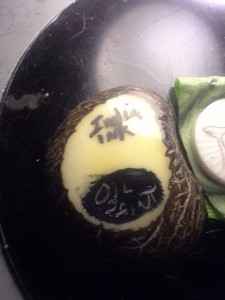
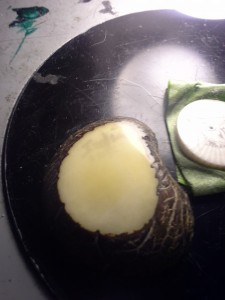
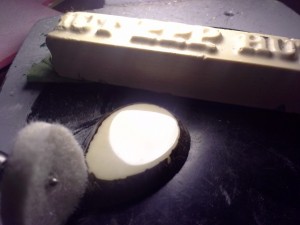
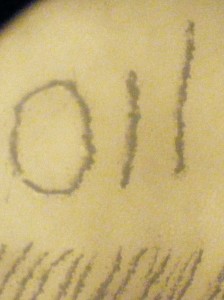
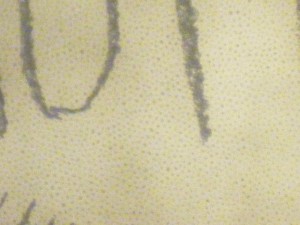
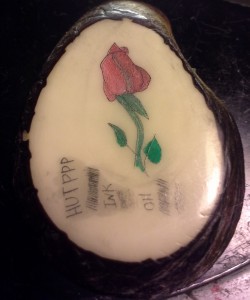
What about using a wax or scilocone waterprof sealer used for hunting boots to seal of the Taguas surface? Once scratched would the ink just go into the scratchs. I may try this.
Hello Hondo, and thanks for writing! I think the wax would work well, the silicone may seep into the pores of the taguanut making the scribe lines waterproof as well, but it would be worth trying out. I tend to use “Renaissance Wax” (available on Amazon.com – and I’m almost out of mine! It’s only been six years, and I’m using it on my wood creations as well). Keep us posted if the silicone works for you, it may be a good alternative!
I decided to use tung oil; it really seems to work well. One coat stays shallow, two may be better. Once the surface it polished and ready to scrimshaw I apply it, but once I re-buffed it that seemed to take the tung oil away and the piece took ink and made it dark. The problem is you have to let the tung oil dry for such a long time, in my area it takes several days.
Thankyou very much for your information on Tagua nut slices for scrimshaw. For a novice like me it is invaluable. I do have one question however. If I send the slices off to have the stabilized won’t that process permeate the entire slice and render all of the material, not just the surface resistant to staining? In that case how does the ink stain the material. As I said, I am a total novice and would like to get as much information as possible before making a substantial investment in tools and material. Thank you for any help you can provide.
It should work fine as long as you allow the pigment to dry completely before wiping it off. If it is stabilized it will be more like alternative ivory made of micarta yet different again. Looking into how some of the more successful tagua scrimshanders are able to do what they do – there are several that are truly amazing.